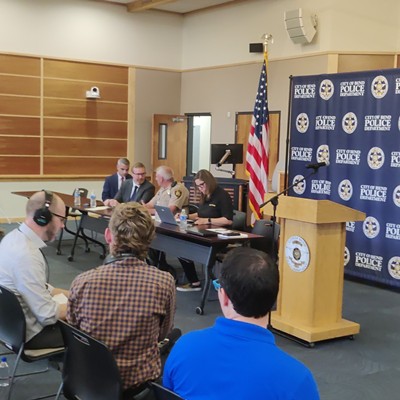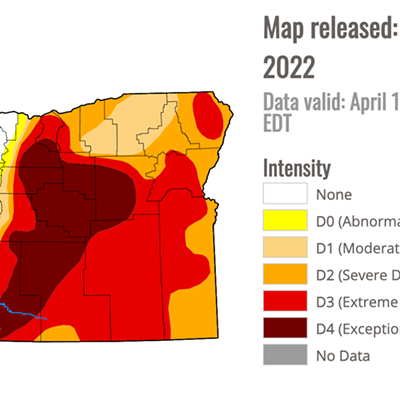It's that time of year, dear ones, for garden lovers to be on the lookout for the local crabs that hang out in your flowers.
Well, not real "crabs," but crab spiders, who are masters at camouflage. Look for it in the photo provided; it's perched right there among the stamens, a forward pair of "arms" outstretched, whispering, "Welcome to my world of flowers...."
Lori Ziegenhagen, a United States Department of Agriculture - Agriculture Research Service Rangeland Research Technician, was hiking down Aldrich Mountain near John Day with her in-laws, Linda and Garth (who were looking for Alaskan Cedar and beating off mosquitoes by the hundreds), when she spotted the lily and shot a fast photo of it. It had to be fast. She says, "I had just taken a few photos of a lady slipper orchid when I saw this lily a few yards away. The mosquitoes were so bad that I couldn't stay in one spot for more than 30 seconds without being carried off, so I took this picture from a standing position, zooming in on the flower, and getting out of there."
She then added, "I didn't see the spider until I got home and looked at the photo on the large screen. Had I known she was there I would have risked the mosquitoes for a closer shot."
And that, oh best beloved, is just the way it is with crab spiders. One doesn't usually see it, (usually a "her") hiding in plain sight, until it moves. It may also have a butterfly, moth or some other insect in its clutches.
Lori also hit the sex of her spider right on the money: It's a she. The male is about 1/3 her size and is usually not far off, waiting for the "right" moment to let her know what he has on his mind without getting gobbled up by his intended sweetheart. (In other places of the Earth, males are 60 times smaller than the female!)
I've known the crab spiders ever since my son Caleb first spotted one hiding in a mustard blossom at Lava Beds National Monument many, many years ago, while helping my wife Sue conduct the butterfly census for the monument.
The crab spider was the same tone of yellow as the flower, and I wouldn't have seen it were it not for sharp-eyed Caleb who saw the checkerspot butterfly the crab spider had in its clutches. For those of you gardeners and flower-lovers, please don't get all pushed out of shape about discovering a crab spider in your flowers. I doubt they are capable of actually "biting" a human, as their fangs are deigned to inject venom into an insect, after which they slobber digestive juices on the prey—which digest it—so the spider can then suck it into their stomachs.
The name crab spider is generally subjective and anecdotal. Part of the family Thomisidae, it's commonly said that it refers to a fancied resemblance to crabs we see along the Oregon Coast. Because of the way such spiders hold their two front pairs of legs, with bodies that are flattened and angular, plus their ability to scuttle sideways or backwards, they end up with the name crab spider.
The females do not, nor need to, build a silken snare to capture prey. They just remain motionless in the vicinity of, or inside a flower until an insect comes to them. In most instances they are close enough to the flower's reproductive system to act as pollinators themselves, while lying in wait for real pollinators to dine upon. They do, however, use silk to make a capsule to hold their precious eggs.
Individuals of some species, such as Misumena varia, are able to change color over a period of some days, matching the flower on which they are sitting. While other species frequent promising positions among leaves or bark, where they await prey, and some will even sit in the open, where they are—of all things—very good mimics of bird droppings.
Now, if you should find yourself in Brazil, in the dry, desert-like habitat of that geographical area, or in Africa, watch out for a lookalike six-eyed crab spider; they are close relatives to the very dangerous brown recluse, or "violin spider" of the Arkansas/Texas neck-of-the-woods.
All have six eyes arranged in three groups of two. They resemble crab spiders of the family Thomisidae, however, they lack the characteristic violin-shaped marking of their cousins, the recluse spider. Remarkably, they live for as long as 15 years, which makes these among the longest-living spiders. Some Tarantulas can live well over 20–30 years, and can live for a very long time without food or water.
If you shoot any pictures of your crab spider, please send them along to [email protected]. Many thanks!


























